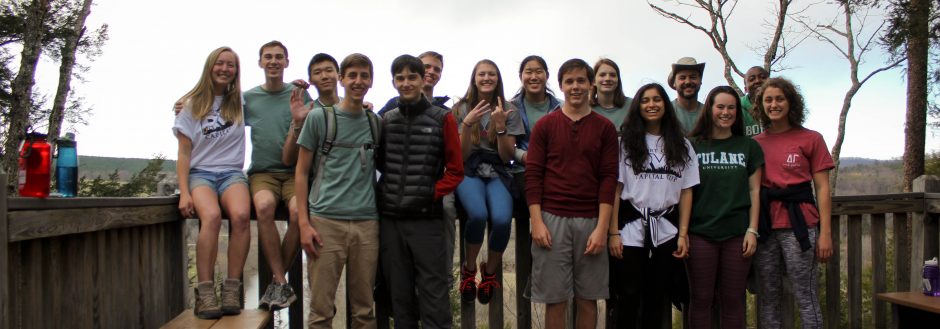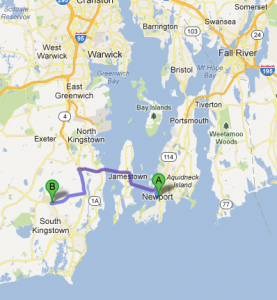Throughout the semester this class has helped me to think of campus in a different way. I have paid more attention to my sense of place, to the nature that surrounds me and the connections between campus and the surrounding environment. The trip to South Carolina last semester was particularly interesting to me because that is my home state. That trip put into sharp contrast for me the differences between my old home and my new home. Having this pointed out to me gave me an interesting lens through which to view our current exploration of place during this semester.
My first blog post was about the day that as a class we went to the creek that feeds the lake. I had never been to that part of campus before and it shocked me to learn that it existed. The same was true for many of my classmates, I remember speaking with Molly and John in particular talked about how they had never seen that part of the lake. Kevin Alloway said in his blog post “the exploration of our school’s watershed helped show me the continuous nature of the water system, and that, while our campus may have definite boundaries, the water that runs in and throughout it certainly does not.” Exploring these parts of campus helps give us a sense of place and gives us perspective. I think this can be said of all the fieldtrips that we have taken as a class.
The visit to the stream got me thinking about the public and private sides of campus. These sides are embodied quite literally by the Commons. On one side there is the view of the lake which all students and visitors see. The beautiful trees that surround the calm lake, the center point of our campus that turns pink and orange when reflecting the sky at sunset. But there is also the private side, the view just on the other side of the commons that we visited as a class. The lake drains into an ugly concrete slope that funnels it into an impervious creek bed. There is an overarching myth that we have an organic and natural campus, but when we look at the actual surfaces that compose our campus we learn that we are overwhelmingly living in an impervious world. There are two sides to any story.
My favorite article that we have read so far for class is Urban Myths. The article starts with a description of the underground of New York City. The author says “These are the guts of the city, the metal intestines that allow suburbs to sprawl and skyscrapers to rise. The fiber-optic cables are nerves, and the subway tunnels are thick jugular veins. Energy is distributed, and waste is digested. All this generates a sort of animal heat, which escapes from grates in the gutters. The foul steam is exhaled breath.”
The article goes on to say that cities obey a similar law for energy consumption as animals. As the size of a city increases, on average each resident becomes more efficient. I wonder what sort of an organism our campus would be. Unlike a city or an organism our campus is carefully planned. I realized to what degree this is true when the architect came to talk to our class. I realized the amount of thought that goes in to planning each new building. The deliberateness of the decision of what facets of campus are public and which will be private, for example the effort to ensure that prospective students are greeted with a view of Boatwright tower as they enter campus.
Unlike a city, we are a community united by a goal; the education of students. All the students and employees of the University are to some degree facilitating that goal. I would like to learn how efficient our campus organism is, to find data that puts our campus into perspective. It is surely efficient in some respects. The average UofR student takes up little living space and all the new buildings are eco friendly. There are recycling bins in all the dorms and dhall publicizes their effort to buy local produce and sustainable seafood. However it is easy to notice the inefficiencies, the wasted food that is whisked away on the conveyer belt in D-hall, the favoring of disposable water bottles at etc. that Jenny talks about in her latest blog post, the TVs and lights that are left on all night. As TLB said recently, the campus itself is only a small piece of our potential to make an impact. Like a national park, if we can lead by example so that every graduate and visitor to our campus leaves with a commitment to live sustainably then our impact will be far larger than anything we could achieve by merely cutting down our own electricity bill.
Campus does not exist in a vacuum. We are a part of the James River Watershed and our actions such as our treatment of the lake and our use of chemicals and impervious surfaces, all affects the river. We don’t live in an intellectual vacuum either. Students often joke about the “Richmond Bubble”, that the difficulty in leaving campus is as much cultural as it is physical. The Gambles Mill trail will offer a partial solution to this feeling of physical isolation. Volunteering for the Environmental Film Festival helped me understand that we do not live in a cultural bubble either. The films I watch were about problems that affect the United States and our campus. Handing out pamphlets and working along side Sierra club volunteers made me feel a part of the community of Richmond.
When we discussed the article Wilderness in class we talked about the three different views about the environment. I found myself most agreeing with the “homebody” view that nature is everywhere. That our campus is still a part of its ecosystem and watershed. Everything we use comes from nature. Our food and water and building materials. The idea that nature exists in some “other” space is clearly not the whole story. I am grateful that we have our natural parks and delight in the time I get to spend in them. Some of my best memories are of times when I was camping in the wilderness. However you do not have to be camping to appreciate the wind on your face or the light on the water. You do not have to be in the woods to appreciate a tree.

